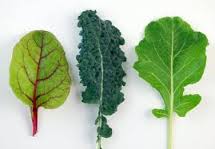Leaf vegetables are mainly eaten for the leaf and / or the leaf veins. Besides raw and fresh in salads, we use them to cook soup or stew. The colors range from green to yellow, but some types anthocycaan turn red. There are varieties of smooth and serrated and flat or curly leaves.
 The leaves are not to keep, unless frozen as warm meal.
The leaves are not to keep, unless frozen as warm meal.
The leafy vegetable best known for warm uses is spinach. (Elder, Lamb's Quarters and others can be used in the same way.)
The most famous cold used are dozens of varieties of lettuce.
We know endive, chicory, celery stalk, nettle, Good King Henry, purslane, young leaves of peas...
Of Good King Henry (Chenopodium bonus - henricus) you can use the young leaves like spinach or lettuce. The young shoots can be cooked as asparagus.
Dandelion as salad is mainly cultivated in France since 1613, and mostly first bleached during growth (by e.g. putting an inverted flowerpot on) so that the taste is less bitter.
Types of lettuce (Lactuca)
Head lettuce is also called butter head.
Cutting lettuce and romaine lettuce (Lactuca sativa var. Crispa) are non -heading, you pick the lower leaves.
The Romans yet did cook their lettuce because he was not yet tender enough.
Cos- or romaine lettuce (Lactuca sativa var longifolia, or -.. Var romana) was about ten days before harvest tied to bleach the leaves. Today, we (also) have self-closing cos.
The name iceberg is derived from the American breed Iceberg, but should really be just ice lettuce or crisp head. The thin, slightly translucent leaves resemble frozen, hence the name.
Romaine lettuce and iceberg lettuce have a longer shelf life if given a quarter less water during growth.
The leaf of oak leaf lettuce (Lactuca sativa) is in the form of that of an oak, and is on the outside reddish-brown colored, the middle part turns green. There are also fully green versions.
Curly lettuce like Lollo Rossa and - Bionda have a loose head and decorative, highly curled red or green leaves.
Arugula or rocket lettuce, is not actually a type of lettuce but cabbage. The elongated, incised leaves have a spicy nutty flavor.
Radicchio rosso is a small round head of red lettuce leaves with white veins.
Clod lettuce is grown with a clod of soil in a greenhouse on water channels, and sold with root ball. This makes it longer lasting and fresher. As cultivation technique it is a good idea. ((It can also on open ground.) You reduce the contact with earth and dirt, fungi and animals. (You can also sprinkle pure sand around the roots.)
Lamb's lettuce (corn- or field salad, Valeria locusta or olitoria) is not (fully) hardy, but continues growing after the frost and is resistant to -9°C. With a little shelter (clock, foil..) you can early harvest. For that reason alone, he is very valuable. You can sow lettuce from mid-August to late September.
Corn salad is spoon-shaped, with deep green leaves that also can be cooked like spinach.
Tear the leaves of lettuce (instead of cutting), then you have less vulnerable cells, and the pores are closing faster and better, and the lettuce stays longer fresh.
Of radish grown for the tubers, the leaves are also edible. Radish comes from the Latin word radix: root.
Cabbages are actually leafy vegetables, but are separately described as a family.
The veins we eat specifically of chard, turnip, celery, rhubarb. But also of ordinary lettuce are the usually ripped away and discarded veins perfectly edible and crispy.
Blanched or boiled grape leaves are also used in dishes. Young leaf of linden or hawthorn can be used in a salad.
Spinach superstition
Warmed spinach is poisonous: wrong.
Bacteria in spinach make the potentially harmful substance nitrite. That can be avoided by storing leftovers to cool quickly to 7 to 4 degrees Celsius. Keep leftovers of nitrate-rich vegetables not more than 2 days in the refrigerator. Do not give it to children under 6 months. You may of course also freeze spinach.
Spinach contains a lot of iron: relative
Fresh spinach contains 2.75 mg iron per 100 grams, which is boiled 3.57 mg. That is relatively much iron.
However, it is inefficient absorbed by our body (i.e. because it easily binds to oxalic acid).
The exaggerated and erroneous estimate comes from a German scientific analysis (1937) in which the point was wrong. The 10x higher value for iron was often reproduced in other publications. And Popeye did the rest. (But eating a plate of spinach makes sure that the muscles work more efficiently.)
Spinach is a healthy vegetable anyway. In addition to iron spinach is rich in potassium, calcium, phosphorus and magnesium, and of vitamin A, vitamin E, folic acid and antioxidants such as lutein and zeaxanthin.
With spinach you can not eat fish: wrong.
The old advice from the Dutch Food Centre turned simply out to be false.
From spinach, you get stiff teeth: possible.
There is some oxalic acid, such as in rhubarb. And that binds to calcium. You can avoid this feeling when cooking by adding just a bit chalk, or milk, or cream.
Spinach melts away during the preparation: partly.
After evaporation you keep around a quarter to a third of the weight. The volume shrinks even more. You can count 450-500 grams of raw spinach per person to get 250 grams of cooked spinach.
